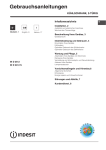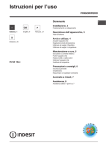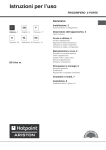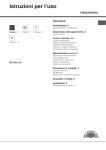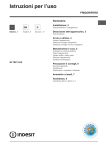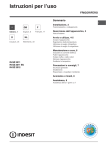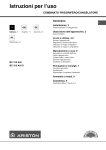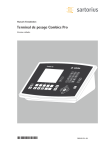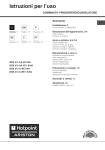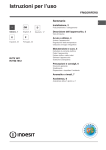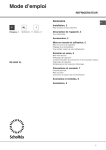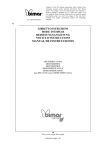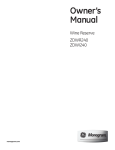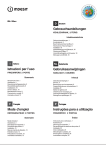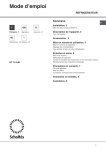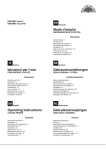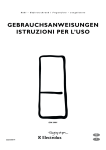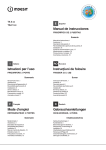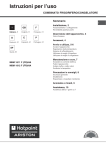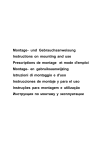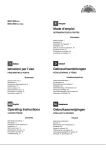Download Istruzioni per l`uso
Transcript
Istruzioni per l’uso FRIGORIFERO Sommario I Italiano, 1 GB English, 11 F Français, 21 Installazione, 2 Posizionamento e collegamento Descrizione dell’apparecchio, 3 Vista d’insieme D Deutsch, 31 Avvio e utilizzo, 4-5 Avviare l’apparecchio Utilizzare al meglio il frigorifero Utilizzare al meglio il congelatore Manutenzione e cura, 6 BSZ 30xx V Escludere la corrente elettrica Pulire l’apparecchio Evitare muffe e cattivi odori Sbrinare l’apparecchio Sostituire la lampadina Precauzioni e consigli, 7 Sicurezza generale Smaltimento Risparmiare e rispettare l’ambiente Anomalie e rimedi, 8 Assistenza, 9 Assistenza attiva 7 giorni su 7 I Installazione I ! È importante conservare questo libretto per poterlo consultare in ogni momento. In caso di vendita, di cessione o di trasloco, assicurarsi che resti insieme all’apparecchio per informare il nuovo proprietario sul funzionamento e sui relativi avvertimenti. ! Leggere attentamente le istruzioni: ci sono importanti informazioni sull’installazione, sull’uso e sulla sicurezza. Posizionamento e collegamento Posizionamento 1. Posizionare l’apparecchio in un ambiente ben aerato e non umido. 2. Non ostruire le griglie posteriori di ventilazione: compressore e condensatore emettono calore e richiedono una buona aerazione per funzionare bene e contenere i consumi elettrici. 3. Lasciare una distanza di almeno 10 cm tra la parte superiore dell’apparecchio ed eventuali mobili sovrastanti e di almeno 5 cm tra le fiancate e mobili/pareti laterali. 4. Lasciare l’apparecchio lontano da fonti di calore (la luce solare diretta, una cucina elettrica). Collegamento elettrico Dopo il trasporto, posizionare l’apparecchio verticalmente e attendere almeno 3 ore prima di collegarlo all’impianto elettrico. Prima di inserire la spina nella presa della corrente, accertarsi che: • la presa abbia la messa a terra e sia a norma di legge; • la presa sia in grado di sopportare il carico massimo di potenza della macchina, indicato nella targhetta caratteristiche posta nel vano frigorifero in basso a sinistra (es 150 W); • la tensione di alimentazione sia compresa nei valori indicati nella targhetta caratteristiche, posta in basso a sinistra (es 220-240 V); • la presa sia compatibile con la spina dell’apparecchio. In caso contrario richiedere la sostituzione della spina a un tecnico autorizzato (vedi Assistenza); non usare prolunghe e multiple. ! Ad apparecchio installato, il cavo elettrico e la presa della corrente devono essere facilmente raggiungibili. ! Il cavo non deve subire piegature o compressioni. ! Il cavo deve essere controllato periodicamente e sostituito solo da tecnici autorizzati (vedi Assistenza). ! L’azienda declina ogni responsabilità qualora queste norme non vengano rispettate. 2 Descrizione dell’apparecchio Vista d’insieme I Le istruzioni sull’uso valgono per diversi modelli per cui è possibile che la figura presenti particolari differenti rispetto a quelli dell’apparecchio acquistato. La descrizione degli oggetti più complessi si trova nelle pagine seguenti. Vano congelatore CONGELAMENTO e CONSERVAZIONE Manopola REGOLAZIONE DELLA TEMPERATURA PURE WIND System RIPIANO• Balconcino estraibile per PICCOLI OGGETTI Balconcino estraibile con coperchio e PORTAUOVA* Balconcino estraibile PORTAOGGETTI• Vano per BOTTIGLIA da 2 LITRI Balconcino BOTTIGLIE Contenitori superiori per FRUTTA e VERDURA DELECATA Contenitore inferiore per FRUTTA e VERDURA • Variabili per numero e/o per posizione. * Presente solo in alcuni modelli. 3 Avvio e utilizzo I Avviare líapparecchio ! Prima di avviare l’apparecchio, seguire le istruzioni sull’installazione (vedi Installazione). ! Prima di collegare l’apparecchio pulire bene i vani e gli accessori con acqua tiepida e bicarbonato. 1. Inserire la spina nella presa e accertarsi che si accenda la lampada di illuminazione interna. 2. Ruotare la manopola per LA REGOLAZIONE DELLA TEMPERATURA su un valore medio. Dopo qualche ora sarà possibile inserire alimenti nel frigorifero. manopola verso i valori più bassi (verrà effettuato uno sbrinamento automatico). RIPIANI: pieni o a griglia. Sono estraibili e regolabili in altezza grazie alle apposite guide (vedi figura), per l’inserimento di contenitori o alimenti di notevole dimensione. Per regolare l’altezza non è necessario estrarre completamente il ripiano. Utilizzare al meglio il frigorifero La temperatura all’interno del reparto frigorifero si regola automaticamente in base alla posizione della manopola del termostato. 1 = meno freddo 5 = più freddo Si consiglia, comunque, una posizione media. Per aumentare lo spazio e disposizione e migliorare l’aspetto estetico, questo apparecchio ha la “parte raffreddante” posizionata all’interno della parete posteriore del reparto frigo. Tale parete, durante il funzionamento, si presenterà coperta di brina, oppure di goccioline di acqua a secondo se il compressore è in funzione o in pausa. Non preoccupatevi di questo! Il frigorifero sta lavorando in modo normale. PURE WIND SYSTEM È riconoscibile dalla presenza del dispositivo sulla parete superiore del vano frigorifero (vedi figura). Wind Pure System ottimizza al massimo la circolazione dell’aria, migliorando l’efficacia dell’evaporatore e contribuendo a raggiungere più rapidamente la giusta temperatura all’interno del frigo dopo ogni apertura. L’aria soffiata (A) si raffredda a contatto della parete fredda, mentre l’aria più calda (B) viene aspirata (vedi figura). Se si imposta la manopola per LA REGOLAZIONE DELLA TEMPERATURA su valori alti, con grossi quantitativi di alimenti e con una temperatura ambiente elevata, l’apparecchio può funzionare di continuo, favorendo un’eccessiva formazione di brina ed eccessivi consumi elettrici: ovviare spostando la 4 Indicatore TEMPERATURA: per individuare la zona più fredda del frigorifero. 1. Controllare che sull’indicatore risulti ben evidente OK (vedi figura). 2. Se non compare la scritta OK significa che la temperatura è troppo elevata: regolare la manopola REGOLAZIONE DELLA TEMPERATURA su una posizione più alta (più freddo) e attendere circa 10 h finché la temperatura si sia stabilizzata. 3. Controllare nuovamente l’indicatore: se necessario, procedere con una nuova regolazione. Se si sono introdotte grosse quantità di alimenti o si è aperta frequentemente la porta del frigorifero, è normale che l’indicatore non segni OK. Attendere almeno 10 h prima di regolare la manopola REGOLAZIONE DELLA TEMPERATURA su una posizione più alta. • Inserire soltanto alimenti freddi o appena tiepidi, non caldi (vedi Precauzioni e consigli). • Ricordarsi che gli alimenti cotti non si mantengono più a lungo di quelli crudi. • Non inserire liquidi in recipienti scoperti: provocherebbero un aumento di umidità con conseguente formazione di condensa. • Le verduriere superiori, più fredde di quella inferiore, sono più adatte per la conservazione di frutta e verdura delicate come: uva, fragole, fichi, ciliege, frutti di bosco, funghi, asparagi, pomodori rossi, carciofi ecc.; mentre quella inferiore per ananas, avocado, cedri, limoni ecc. Líigiene alimentare 1. Dopo l’acquisto degli alimenti, eliminare qualsiasi tipo di confezione esterna in carta/cartone o altri involucri, che potrebbero introdurre nel frigo batteri o sporcizia. 2. Proteggere gli alimenti, (in particolare quelli facilmente deperibili e quelli che emanano un forte aroma), in modo da evitate il contatto tra essi, eliminando in questo modo sia la possibilità di contaminazione di germi/batteri, che la diffusione di particolari odori all’interno del frigo 3. Riporre i cibi in modo in modo che l’aria possa circolare liberamente tra essi 4. Tenere pulito l’interno del frigo, facendo attenzione a non utilizzare prodotti ossidanti o abrasivi Utilizzare al meglio il congelatore I • Non ricongelare alimenti che stanno per scongelare o scongelati; tali alimenti devono essere cotti per essere consumati (entro 24 ore). • Gli alimenti freschi da congelare non devono essere posti a contatto con quelli già congelati; vanno sistemati sopra la griglia del reparto freezer possibilmente a contatto delle pareti (laterali e posteriore) dove la temperatura scende sotto i -18°C e garantisce una buona velocità di congelamento. • Non mettere nel congelatore bottiglie di vetro contenenti liquidi, tappate o chiuse ermeticamente, perché potrebbero rompersi. • La quantità massima giornaliera di alimenti da congelare è indicata sulla targhetta caratteristiche, posta nel vano frigorifero in basso a sinistra (esempio: Kg/24h 4). ! Durante il congelamento evitare di aprire la porta. ! In caso di interruzione di corrente o di guasto, non aprire la porta del congelatore: in questo modo congelati e surgelati si conserveranno senza alterazioni per circa 9-14 ore. ! Se per lungo tempo permane la temperatura ambiente più fredda di 14°C, non si raggiungono completamente le temperature necessarie per una lunga conservazione nel reparto freezer e il periodo di conservazione risulterà pertanto ridotto. 5. Togliere gli alimenti dal frigo una volta superata la durata massima di conservazione 6. Per una buona conservazione, i cibi facilmente deperbili ( formaggi molli, pesce crudo, carne, etc…) vanno posizionati nella zona più fredda, cioè quella sopra le verduriere, dove si trova l’indicatore della temperatura 5 Manutenzione e cura I Escludere la corrente elettrica Sbrinare il vano congelatore Durante i lavori di pulizia e manutenzione è necessario isolare l’apparecchio dalla rete di alimentazione staccando la spina dalla presa. Non è sufficiente portare la manopola per la regolazione della temperatura sulla posizione (apparecchio spento) per eliminare ogni contatto elettrico. Se lo strato di brina è superiore ai 5 mm è necessario effettuare lo sbrinamento manuale: Pulire l’apparecchio • Le parti esterne, le parti interne e le guarnizioni in gomma possono essere pulite con una spugnetta imbevuta di acqua tiepida e bicarbonato di sodio o sapone neutro. Non usare solventi, abrasivi, candeggina o ammoniaca. • Gli accessori estraibili possono essere messi a bagno in acqua calda e sapone o detersivo per piatti. Sciacquarli e asciugarli con cura. Evitare muffe e cattivi odori • L’apparecchio è fabbricato con materiali igienici che non trasmettono odori. Per mantenere questa caratteristica è necessario che i cibi vengano sempre protetti e chiusi bene. Ciò eviterà anche la formazione di macchie. • Nel caso si voglia spegnere l’apparecchio per un lungo periodo, pulire l’interno e lasciare le porte aperte. Sbrinare l’apparecchio ! Attenersi alle istruzioni sottostanti. Per sbrinare l’apparecchio non usare oggetti taglienti ed appuntiti che potrebbero danneggiare irreparabilmente il circuito refrigerante.. Sbrinare il vano frigorifero Il frigorifero è dotato di sbrinamento automatico: l’acqua viene convogliata verso la parte posteriore da un apposito foro di scarico (vedi figura) dove il calore prodotto dal compressore la fa evaporare. L’unico intervento da fare periodicamente consiste nel pulire il foro di scarico affinché l’acqua possa defluire liberamente. 6 1. Posizionare la manopola per LA REGOLAZIONE DELLA TEMPERATURA nella posizione . 2. Avvolgere surgelati e congelati in carta da giornale e metterli in un altro congelatore o in un luogo fresco. 3. Lasciare aperta la porta finché la brina non si sia sciolta completamente; facilitare l’operazione sistemando nel vano congelatore contenitori con acqua tiepida. 4. Alcuni apparecchi sono dotati del SISTEMA DRAIN per convogliare l’acqua all’esterno (vedi figura). 5. Pulire e asciugare con cura il vano congelatore prima di riaccendere l’apparecchio. 6. Prima di inserire i cibi nel vano congelatore attendere circa 2 ore per il ripristino delle condizioni ideali di conservazione. Sostituire la lampadina Per sostituire la lampadina di illuminazione del vano frigorifero, staccare la spina dalla presa di corrente. Seguire le istruzioni riportate qui sotto. Accedere alla lampada togliendo la protezione come indicato in figura. Sostituirla con una analoga di potenza a quella indicata sulla protezione (10 W o 15 W). Precauzioni e consigli ! L’apparecchio è stato progettato e costruito in conformità alle norme internazionali di sicurezza. Queste avvertenze sono fornite per ragioni di sicurezza e devono essere lette attentamente. Questa apparecchiatura è conforme alle seguenti Direttive Comunitarie: - 73/23/CEE del 19/02/73 (Bassa Tensione) e successive modificazioni; - 89/336/CEE del 03/05/89 (Compatibilità Elettromagnetica) e successive modificazioni; - 2002/96/CE.. Sicurezza generale • L’apparecchio è stato concepito per un uso di tipo non professionale all’interno dell’abitazione. • L’apparecchio deve essere usato per conservare e congelare cibi, solo da persone adulte e secondo le istruzioni riportate in questo libretto. • L’apparecchio non va installato all’aperto, nemmeno se lo spazio è riparato, perché è molto pericoloso lasciarlo esposto a pioggia e temporali. • Non toccare l’apparecchio a piedi nudi o con le mani o i piedi bagnati o umidi. Smaltimento I • Smaltimento del materiale di imballaggio: attenersi alle norme locali, così gli imballaggi potranno essere riutilizzati. • La direttiva Europea 2012/19/EU sui rifiuti di apparecchia¬ture elettriche ed elettroniche (RAEE), prevede che gli elettrodo¬mestici non debbano essere smaltiti nel normale flusso dei rifiuti solidi urbani. Gli apparecchi dismessi devono essere raccolti separatamente per ottimizzare il tasso di recupero e riciclaggio dei materiali che li compongono ed impedire potenziali danni per la salute e l’ambiente. Il simbolo del cestino barrato è riportato su tutti i prodotti per ricordare gli obblighi di raccolta separata. Quando si acquista una nuova apparecchiatura equivalente si può consegnare il RAEE al negoziante, che è tenuto a ritirarlo gratuitamente; i RAEE di “piccolissime dimensioni” (nessun lato sopra i 25 cm) possono essere consegnati gratuitamente ai negozianti anche se non si acquista nulla (solo nei negozi con superficie di vendita superiore a 400 mq). Per ulteriori informazioni sulla corretta dismissione degli elettrodomestici i detentori potranno rivolgersi al servizio pubblico preposto o ai rivenditori.ri. • Non toccare le parti interne raffreddanti: c’è pericolo di ustionarsi o ferirsi. Risparmiare e rispettare l’ambiente • Non staccare la spina dalla presa della corrente tirando il cavo, bensì afferrando la spina. • Installare l’apparecchio in un ambiente fresco e ben aerato, proteggerlo dall’esposizione diretta ai raggi solari, non disporlo vicino a fonti di calore. • È necessario staccare la spina dalla presa prima di effettuare operazioni di pulizia e manutenzione. Non è sufficiente portare la manopola per LA REGOLAZIONE DELLA TEMPERATURA sulla posizione (apparecchio spento) per eliminare ogni contatto elettrico. • In caso di guasto, in nessun caso accedere ai meccanismi interni per tentare una riparazione. • Non utilizzare, all’interno degli scomparti conservatori di cibi congelati, utensili taglienti ed appuntiti o apparecchi elettrici se non sono del tipo raccomandato dal costruttore. • Non mettere in bocca cubetti appena estratti dal congelatore. • Non permettere ai bambini di giocare con l’apparecchio. In nessun caso devono sedersi sui cassetti o appendersi alla porta. • Per introdurre o estrarre gli alimenti, aprire le porte dell’apparecchio il più brevemente possibile. Ogni apertura delle porte causa un notevole dispendio di energia. • Non riempire con troppi alimenti l’apparecchio: per una buona conservazione, il freddo deve poter circolare liberamente. Se si impedisce la circolazione, il compressore lavorerà continuamente. • Non introdurre alimenti caldi: alzerebbero la temperatura interna costringendo il compressore a un grosso lavoro, con grande spreco di energia elettrica. • Sbrinare l’apparecchio qualora si formasse del ghiaccio (vedi Manutenzione); uno spesso strato di ghiaccio rende più difficile la cessione di freddo agli alimenti e fa aumentare il consumo di energia. • Gli imballaggi non sono giocattoli per bambini. 7 Anomalie e rimedi I Può accadere che l’apparecchio non funzioni. Prima di telefonare all’Assistenza (vedi Assistenza), controllare che non si tratti di un problema facilmente risolvibile aiutandosi con il seguente elenco. Anomalie: Possibili cause / Soluzione: La lampada di illuminazione interna non si accende. • La spina non è inserita nella presa della corrente o non abbastanza da fare contatto, oppure in casa non c’è corrente. • Le porte non chiudono bene o le guarnizioni sono rovinate. • Le porte vengono aperte molto spesso. • La manopola per LA REGOLAZIONE DELLA TEMPERATURA non è in posizione corretta • Il frigorifero o il congelatore sono stati riempiti eccessivamente. • La temperatura ambiente di lavoro del prodotto è inferiore a 14°C. Il frigorifero e il congelatore raffreddano poco. Nel frigorifero gli alimenti si gelano. • La manopola per LA REGOLAZIONE DELLA TEMPERATURA non è in posizione corretta. • Gli alimenti sono a contatto con la parete posteriore. La ventola PURE WIND non gira. • I sistema PURE WIND si attiva automaticamente solo quando necessario per ripristinare le condizioni ottimali all’interno del vano frigorifero. Il motore funziona di continuo. • La porta non è ben chiusa o viene aperta di continuo. • La temperatura dell’ambiente esterno è molto alta. • Lo spessore della brina supera i 2-3 mm (vedi Manutenzione). L’apparecchio emette molto rumore. • L’apparecchio non è stato installato ben in piano (vedi Installazione). • L’apparecchio è stato installato tra mobili o oggetti che vibrano ed emettono rumori. • Il gas refrigerante interno produce un leggero rumore anche quando il compressore è fermo: non è un difetto, è normale. La temperatura di alcune parti esterne del frigorifero è elevata. • Le temperature elevate sono necessarie per evitare la formazioni di condensa in particolari zone del prodotto La parete in fondo alla cella frigo presenta brina o goccioline di acqua. • Si tratta del normale funzionamento del prodotto. Sul fondo del frigo c’è dellíacqua. • Il foro di scarico dell’acqua è otturato (vedi Manutenzione). 8 Assistenza Prima di contattare l’Assistenza: • Verificare se l’anomalia può essere risolta autonomamente (vedi Anomalie e Rimedi). • In caso negativo, contattare il Numero Unico Nazionale 199.199.199. modello I numero di serie Comunicare: • il tipo di anomalia • il modello della macchina (Mod.) • il numero di serie (S/N) Queste informazioni si trovano sulla targhetta caratteristiche posta nel vano frigorifero in basso a sinistra. Assistenza Attiva 7 giorni su 7 Se nasce il bisogno di assistenza o manutenzione basta chiamare il Numero Unico Nazionale 199.199.199*. Un operatore sarà a tua completa disposizione per fissare un appuntamento con un tecnico del Centro Assistenza Autrorizzato più vicino a casa tua. È attivo 7 giorni su 7, sabato e domenica compresi, e non lascia mai inascoltata una richiesta. *Al costo di 14,25 centesimi di Euro al minuto(iva inclusa) dal Lun. al Ven. dalle 08:00 alle 18:30, il Sab. dalle 08:00 alle 13:00 e di 5,58 centesimi di Euro al minuto (iva inclusa) dal Lun. al Ven. dalle 18:30 alle 08:00, il Sab. dalle 13:00 alle 08:00 e i giorni festivi, per chi chiama da telefono fisso. Per chi chiama da radiomobile le tariffe sono legate al piano tariffario dell’operatore telefonico utilizzato. 9 195073523.02 10/2014 I 10 Operating Instructions REFRIGERATOR Contents I Italiano, 1 GB English, 11 F Français, 21 GB GB Installation, 12 Positioning and connection Description of the appliance, 13 Overall view D Deutsch, 31 Start-up and use, 14-15 Starting the appliance Using the refrigerator to its full potential Using the freezer to its full potential Maintenance and care, 16 BSZ 30xx V Switching the appliance off Cleaning the appliance Avoiding mould and unpleasant odours Defrosting the appliance Replacing the light bulb Precautions and tips, 17 General safety Disposal Respecting and conserving the environment Troubleshooting, 18 Assistance, 19 11 Installation GB ! Before operating your new appliance, please read these operating instructions carefully. They contain important information for safe use, installation and care of the appliance. ! Please keep these operating instructions for future reference. Pass them on to possible new owners of the appliance. Positioning and connection Positioning 1.Place the appliance in a well-ventilated humidity-free room. 2.Do not obstruct the rear fan grills. The compressor and condenser give off heat and require good ventilation to operate correctly and save energy. 3.Ensure the appliance is far away from any sources of heat (direct sunlight, electric stove, etc.). Electrical connections After transportation of the appliance, carefully place it vertically and wait at least 3 hours before connecting it to the electricity mains. Before inserting the plug into the electrical socket ensure the following: • The appliance is earthed and the plug is compliant with the law. • The socket can withstand the maximum power of the appliance, which is indicated on the data plate located on the bottom left side of the fridge (e.g. 150 W). • The voltage must be in the range between the values indicated on the data plate located on the bottom left side (e.g. 220-240V). • The socket is compatible with the plug of the appliance. If the socket is incompatible with the plug, ask an authorised technician to replace it (see Assistance). Do not use extension cords or multiple sockets. ! Once the appliance has been installed, the power supply cable and the electrical socket must be easily accessible. ! The cable must not be bent or compressed. ! The cable must be checked regularly and replaced by authorised technicians only (see Assistance). ! The manufacturer declines any liability should these safety measures not be observed. 12 Description of the appliance Overall view GB The instructions contained in this manual are applicable to different model refrigerators. The diagrams may not directly represent the appliance purchased. For more complex features, consult the following pages. FREEZER and STORAGE compartment TEMPERATURE REGULATING Knob PURE WIND System SHELVES• Removable shelf for SMALL ITEMS Removable lidded shelf with EGG TRAY* Removable multipurpose SHELVES• Compartment for a 2 LITRE BOTTLE BOTTLE shelf Top drawers for HIGHLY PERISHABLES FRUIT and VEGETABLE Bottom FRUIT and VEGETABLE drawer • Varies by number and/or position. * Available only on certain models. 13 Start-up and use GB Starting the appliance ! Before starting the appliance, follow the installation instructions (see Installation). ! Before connecting the appliance, clean the compartments and accessories well with lukewarm water and bicarbonate. 1.Insert the plug into the socket and ensure that the internal light illuminates. 2.Turn the TEMPERATURE ADJUSTMENT knob to an average value. After a few hours you will be able to put food in the refrigerator. Using the refrigerator to its full potential The temperature inside the refrigerator compartment automatically adjusts itself according to the position of the thermostat knob. 1 = warmest 5 = coldest We recommend, however, a medium position. The cooling section of the refrigerator is located inside the back wall of the refrigerator compartment for increased space and improved aesthetics. During operation, the back wall will be covered in frost or water droplets depending on whether the compressor is operating or paused. Do not worry, the refrigerator is functioning normally. PURE WIND SYSTEM It is recognizable due to the presence of the mechanism on the top part of the refrigerator compartment (see diagram). Pure Wind System maximises air circulation, improving the efficiency of the evaporator and helping to achieve the optimal temperature inside the refrigerator as quickly as possible each time it has been opened. The blown air (A) is cooled when it comes into contact with the cold wall, whereas the hotter air (B) is sucked up (see diagram). If the TEMPERATURE ADJUSTMENT knob has been set on high values with large quantities of food and with a high ambient temperature, the appliance can operate continuously, resulting in excessive frost formation and excessive energy consumption: compensate for this by shifting the knob towards lower values (defrosting will occur automatically). 14 SHELVES: with or without grill. Due to the special guides the shelves are removable and the height is adjustable (see diagram), allowing easy storage of large containers and food. Height can be adjusted without complete removal of the shelf. TEMPERATURE Indicator light: to identify the coldest area in the refrigerator. 1.Check that OK appears clearly on the indicator light (see diagram). 2.If the word “OK” does not appear it means that the temperature is too high: adjust the REFRIGERATOR OPERATION knob to a higher position (colder) and wait approximately 10 hours until the temperature has been stabilised. 3.Check the indicator light again: if necessary, readjust it following the initial process. If large quantities of food have been added or if the refrigerator door has been opened frequently, it is normal for the indicator not to show OK. Wait at least 10 hours before adjusting the REFRIGERATOR OPERATION knob to a higher setting. • Place only cold or lukewarm foods in the compartment, not hot foods (see Precautions and tips). • Remember that cooked foods do not last longer than raw foods. • Do not store liquids in open containers. They will increase humidity in the refrigerator and cause condensation to form. • The top salad crispers, which are colder than the bottom one, are more suited to the preservation of delicate fruits and vegetables such as: grapes, strawberries, figs, cherries, fruits of the forest, mushrooms, asparagus, red tomatoes, artichokes etc.; whereas the bottom crisper is ideal for storing pineapples, avocados, citrons, lemons etc. Food hygiene 1. Once you have bought your food, remove all external packaging made of paper/cardboard or other wrappers, which could introduce bacteria or dirt inside your refrigerator. 2. Protect the food, (especially easily perishable items and those that have a strong smell), in order to avoid contact between them, thereby removing both the possibility of germ/bacteria contamination as well as the diffusion of strong odours inside the fridge. Using the freezer to its full potential GB • Do not re-freeze food that is defrosting or that has already been defrosted. These foods must be cooked and eaten (within 24 hours). • Fresh food that needs to be frozen must not come into contact with food that has already been defrosted. Fresh food must be stored above the grill in the freezer compartment and if possible be in direct contact with the walls (side and rear), where the temperature drops below -18°C and guarantees rapid freezing. • Do not place glass bottles which contain liquids, and which are corked or hermetically sealed in the freezer because they could break. • The maximum quantity of food that may be frozen daily is indicated on the plate containing the technical properties located on the bottom left side of the refrigerator compartment (for example: Kg/24h: 4) ! Do not open the door during freezing. ! If there is a power cut or malfunction, do not open the freezer door. This will help maintain the temperature inside the freezer, ensuring that foods are conserved for at least 9 -14 hours. ! If the room temperature drops below 14°C for an extended period of time, the ideal temperature will not be reached in the freezer compartment and food preservation will be reduced. 3. Store all food in such a way as to ensure air can circulate freely between different items. 4. Keep the inside of your fridge clean, taking care not to use oxidiser or abrasive products. 5. Remove all food past its expiry date from the refrigerator. 6. For the correct preservation of food, all easily perishable items (soft cheeses, raw fish, meat, etc.) should be stored in the coldest zone of the fridge compartment, i.e. just above the salad crisper where the temperature indicator is situated. 15 Maintenance and care GB Switching the appliance off During cleaning and maintenance it is necessary to disconnect the appliance from the electricity supply: It is not sufficient to set the temperature adjustment knobs on (appliance off) to eliminate all electrical contact. Cleaning the appliance • The external and internal parts, as well as the rubber seals may be cleaned using a sponge that has been soaked in lukewarm water and bicarbonate of soda or neutral soap. Do not use solvents, abrasive products, bleach or ammonia. • The removable accessories may be soaked in warm water and soap or dishwashing liquid. Rinse and dry them carefully. • The back of the appliance may collect dust which can be removed by delicately using the hose of a vacuum cleaner set on medium power. The appliance must be switched off and the plug must be pulled out before cleaning the appliance. It is necessary to clean the discharge hole regularly so that the water can flow out easily. Defrosting the freezer compartment If the frost layer is greater than 5 mm, it is necessary to defrost manually: 1.Set the TEMPERATURE ADJUSTMENT knob to the position . 2.Wrap frozen foods in newspaper and place them in another freezer or in a cool place. 3.Leave the door open until the frost has melted completely. This can be made easier by placing containers with lukewarm water in the freezer compartment. 4. Certain appliances are fitted with the DRAIN SYSTEM to lead the water outside: let the water flow into a container (see diagram). Avoiding mould and unpleasant odours • The appliance is manufactured with hygienic materials which are odour free. In order to maintain an odour free refrigerator and to prevent the formation of stains, food must always be covered or sealed properly. • If you want to switch the appliance off for an extended period of time, clean the inside and leave the doors open. Defrosting the appliance 5. Clean and dry the freezer compartment carefully before switching the appliance on again. 6. Wait for approximately 2 hours, i.e. until the ideal storage conditions have been restored, before placing food in the freezer compartment. Replacing the light bulb To replace the light bulb in the refrigerator compartment, pull out the plug from the electrical socket. Follow the instructions below. Access the light bulb by removing the cover as indicated in the diagram. Replace it with a similar light bulb within the power range indicated on the ! Follow the instructions below. Do not use objects with sharp or pointed edges to defrost the appliance as these may damage the refrigeration circuit beyond repair. Defrosting the refrigerator compartment The refrigerator has an automatic defrosting function: water is ducted to the back of the appliance by a special discharge outlet (see diagram) where the heat produced by the compressor causes it to evaporate. 16 cover (10W or 15W). Precautions and tips ! The appliance was designed and manufactured in compliance with international safety standards. The following warnings are provided for safety reasons and must be read carefully. Disposal GB • Observe local environmental standards when disposing packaging material for recycling purposes. • The appliance must be used to store and freeze food products by adults only and according to the instructions in this manual. • The European Directive 2012/19/EU on Waste Electrical and Electronic Equipment (WEEE), requires that old household electrical appliances must not be disposed of in the normal unsorted municipal waste stream. Old appliances must be collected separately in order to optimise the recovery and recycling of the materials they contain and reduce the impact on human health and the environment. The crossed out “wheeled bin” symbol on the product reminds you of your obligation, that when you dispose of the appliance it must be separately collected. Consumers may take their old appliance to public waste collection areas, other communal collection areas, or if national legislation allows return it to a retailer when purchasing a similar new product. All major household appliance manufacturers are active in the creation of systems to manage the collection and disposal of old appliances. • The appliance must not be installed outdoors, even in covered areas. It is extremely dangerous to leave the appliance exposed to rain and storms. Respecting and conserving the environment This appliance complies with the following Community Directives: - 73/23/EEC of 19/02/73 (Low Voltage) and subsequent amendments; -89/336/EEC of 03.05.89 (Electromagnetic Compatibility) and subsequent amendments; - 2002/96/CE.. General safety • The appliance was designed for domestic use inside the home and is not intended for commercial or industrial use. • Do not touch the appliance with bare feet or with wet or moist hands and feet. • Do not touch the internal cooling elements: this could cause skin abrasions or frost/freezer burns. • When unplugging the appliance always pull the plug from the mains socket, do not pull on the cable. • Before cleaning and maintenance, always switch off the appliance and disconnect it from the electrical supply. It is not sufficient to set the temperature adjustment knobs on (appliance off) to eliminate all electrical contact. • In the case of a malfunction, under no circumstances should you attempt to repair the appliance yourself. Repairs carried out by inexperienced persons may cause injury or further malfunctioning of the appliance. • Do not use any sharp or pointed utensils or electrical equipment - other than the type recommended by the manufacturer - inside the frozen food storage compartments. • Do not put ice cubes taken directly from the freezer into your mouth. • Do not allow children to tamper with the controls or play with the appliance. Under no circumstance should they be allowed to sit on the bins or to hang from the door. • Install the appliance in a fresh and well-ventilated room. Ensure that it is protected from direct sunlight and do not place it near heat sources. • Try to avoid keeping the door open for long periods or opening the door too frequently in order to conserve energy. • Do not fill the appliance with too much food: cold air must circulate freely for food to be preserved properly. If circulation is impeded, the compressor will work continuously. • Do not place hot food directly into the refrigerator. The internal temperature will increase and force the compressor to work harder and will consume more energy. • Defrost the appliance if ice forms (see Maintenance). A thick layer of ice makes cold transference to food products more difficult and results in increased energy consumption. • Regularly check the door seals and wipe clean to ensure they are free of debris and to prevent cold air from escaping (see Maintenance). • Keep packaging material out of the reach of children! It can become a choking or suffocation hazard. 17 Troubleshooting GB If the appliance does not work, before calling for Assistance (see Assistance), check for a solution from the following list. Malfunctions: Possible causes / Solutions: • The plug has not been inserted into the electrical socket, or not far enough to make contact, or there is no power in the house. The refrigerator and the freezer do not cool well. • The doors do not close properly or the seals are damaged. • The doors are opened too frequently. • The TEMPERATURE ADJUSTMENT knob is not in the correct position • The refrigerator or the freezer have been over-filled. • The atmospheric temperature of the area surrounding the appliance is lower than 14°C. The food inside the refrigerator is • The TEMPERATURE ADJUSTMENT knob is not in the correct position. beginning to freeze. • The food is in contact with the back inside wall of the refrigerator. The internal light does not illuminate. The PURE WIND fan does not rotate. • The PURE WIND system is only activated automatically when it becomes necessary to restore perfect operational conditions inside the refrigerator compartment. The motor runs continuously. • The door is not closed properly or is continuously opened. • The outside ambient temperature is very high. • The thickness of the frost exceeds 2-3 mm (see Maintenance). The appliance makes a lot of noise. • The appliance has not been installed on a level surface (see Installation). • The appliance has been installed between cabinets that vibrate and make noise. • The internal refrigerant makes a slight noise even when the compressor is off. This is not a defect, it is normal. Some of the external parts of the refrigerator become hot. • These raised temperatures are necessary in order to avoid the formation of condensation on certain parts of the product. The back wall of the refrigerator unit is covered in frost or droplets of water. • This shows the appliance is operating normally. There is water at the bottom of the refrigerator. • The water discharge hole is blocked (see Maintenance). 18 Assistance Before calling for Assistance: • Check if the malfunction can be solved on your own (see Troubleshooting). • If after all the checks, the appliance still does not operate or the problem persists, call the nearest Service Centre model serial number Communicating: • type of malfunction • appliance model (Mod.) • serial number (S/N) This information can be found on the data plate located on the bottom left side of the refrigerator compartment. Never call on unauthorized technicians and always refuse spare parts which are not originals. 19 GB 195073523.02 10/2014 GB 20 Mode díemploi REFRIGERATEUR Sommaire I Italiano, 1 GB English, 11 F Français, 21 F F Installation, 22 Mise en place et raccordement Description de l’appareil, 23 Vue d’ensemble D Deutsch, 31 Mise en marche et utilisation, 24-25 Mise en service de l’appareil Pour profiter à plein de votre réfrigérateur Pour profiter à plein de votre congélateur Entretien et soins, 26 BSZ 30xx V Mise hors tension Nettoyage de l’appareil Contre la formation de moisissures et de mauvaises odeurs Dégivrage de l’appareil Remplacement de l’ampoule d’éclairage Précautions et conseils, 27 Sécurité générale Mise au rebut Economies et respect de l’environnement Anomalies et remédes, 28 Assistance, 29 21 Installation F ! Conservez ce mode d’emploi pour pouvoir le consulter à tout moment. En cas de vente, de cession ou de déménagement, veillez à ce qu’il suive l’appareil pour informer le nouveau propriétaire sur son fonctionnement et lui fournir les conseils correspondants. ! Lisez attentivement les instructions : elles contiennent des conseils importants sur l’installation, l’utilisation et la sécurité de votre appareil. Mise en place et raccordement Mise en place 1.Placez l’appareil dans une pièce bien aérée et non humide. 2.Ne bouchez pas les grilles d’aération arrière : le compresseur et le condensateur produisent de la chaleur et exigent une bonne aération pour bien fonctionner et réduire la consommation d’électricité. 3.Installez l’appareil loin de sources de chaleur (rayons directs du soleil, cuisinière électrique). Raccordement électrique Après le transport, placez l’appareil à la verticale et attendez au moins 3 heures avant de le raccorder à l’installation électrique. Avant de brancher la fiche dans la prise de courant, assurez-vous que : • la prise est bien munie d’une terre conforme à la loi; • la prise est bien apte à supporter la puissance maximale de l’appareil, indiquée sur la plaquette signalétique placée à l’intérieur du compartiment réfrigérateur en bas à gauche (ex. 150 W); • la tension d’alimentation est bien comprise entre les valeurs indiquées sur la plaquette signalétique, placée en bas à gauche (ex.220-240 V); • la prise est bien compatible avec la fiche de l’appareil. En cas d’incompatibilité, faites remplacer la fiche par un technicien agréé (voir Assistance); n’utilisez ni rallonges ni prises multiples. ! Après installation de l’appareil, le câble électrique et la prise de courant doivent être facilement accessibles. ! Le câble ne doit être ni plié ni excessivement écrasé. ! Il doit être contrôlé prériodiquement et ne peut être remplacé que par un technicien agréé (voir Assistance). ! Nous dèclinons toute responsabilitè en cas de non respect des normes ènumèrèes ci-dessus. 22 Description de l’appareil Vue d’ensemble F Ces instructions d’utilisation s’appliquent à plusieurs modèles, il se peut donc que les composants illustrés présentent des différences par rapport à ceux de l’appareil que vous avez acheté. Vous trouverez dans les pages suivantes la description des objets plus complexes. Compartiment CONGELATION et CONSERVATION Commande pour REGLER LA TEMPERATURE PURE WIND System CLAYETTE• Balconnet amovible pour PETIT OBJETSï Balconnet amovible à abattant, contenant un SUPPORT A OEUFS* Balconnet amovible PORTE-OBJETS • Compartimant pour BOUTEILLE 2 LITRES Balconnet BOUTEILLES Bacs supérieurs pour FRUITS et LEGUMES FACILEMENT PERISSABLES Bac inférieur pour FRUITS et LEGUMES •Leur nombre et/ou leur emplacement peut varier. * N’existe que sur certains modèles. 23 Mise en marche et utilisation F Mise en service de l’appareil ! Avant de mettre l’appareil en service, suivez bien les instructions sur l’installation (voir Installation). ! Avant de brancher votre appareil, nettoyez bien les compartiments et les accessoires à l’eau tiède additionnée de bicarbonate. 1.Branchez la fiche dans la prise de courant et assurez-vous que l’éclairage intérieur s’allume. 2.Amenez le bouton de REGLAGE DE LA TEMPERATURE sur une valeur intermédiaire. Au bout de quelques heures, vous pourrez commencer à stocker des aliments dans le réfrigérateur. fonctionner de façon continue, ce qui entraîne une formation abondante de givre et une consommation d’électricité excessive: amenez alors le bouton sur des valeurs plus basses (un dégivrage automatique sera lancé). CLAYETTES: pleines ou grillagées. Elles sont amovibles et réglables en hauteur grâce à des glissières spéciales (voir figure), pour le rangement de récipients ou d’aliments de grande dimension. Pour régler la hauteur, pas besoin de sortir la clayette complètement. Pour profiter à plein de votre réfrigérateur Le ràglage de la température à l’intérieur du compartiment réfrigérateur est automatique en fonction de la position du bouton du thermostat. 1 = moins froid 5 = plus froid Nous conseillons toutefois une position intermédiaire. Pour augmenter la place disponible, simplifier le rangement et améliorer l’aspect esthétique, cet appareil loge sa “partie refroidissante” à l’intérieur de la paroi arrière du compartiment réfrigérateur. Pendant le fonctionnement de l’appareil, cette paroi est tour à tour couverte de givre ou de gouttelettes d’eau selon que le compresseur est en marche ou à l’arrêt. Ne vous inquiétez pas ! Votre réfrigérateur fonctionne normalement. PURE WIND On le reconnaît à la présence d’un dispositif appliqué à la paroi dans le haut du compartiment réfrigérateur (voir figure). Wind Pure qui optimise au maximum la circulation de l’air, améliore l’efficacité de l’évaporateur et contribue à rétablir très rapidement la température à l’intérieur du réfrigérateur après chaque ouverture. L’air soufflé (A) refroidit au contact de la paroi froide, tandis que l’air plus chaud (B) est aspiré (voir figure). Si vous amenez le bouton de REGLAGE DE LA TEMPERATURE sur des valeurs plus élevées, que vous stockez de grandes quantités d’aliments et que la température ambiante est élevée, votre appareil peut 24 Indicateur de TEMPERATURE: pour repérer la zone la plus froide à l’intérieur du réfrigérateur. 1. Contrôler que l’indicateur affiche bien OK (voir figure). 2 . Si le message OK n’est pas affiché, c’est que la température est trop élevée : régler le bouton FONCTIONNEMENT REFRIGERATEUR sur un numéro plus élevé (plus froid) et attendre environ 10 h jusqu’à ce que la température se stabilise. 3. Contrôler l’indicateur une nouvelle fois : si nécessaire, procéder à un nouveau réglage. Si de grosse quantités d’aliments ont été stockées ou si la porte du réfrigérateur est ouverte très souvent, il est normal que l’indicateur n’indique pas OK. Attendre au moins 10 h avant de régler le bouton FONCTIONNEMENT REFRIGERATEUR sur un chiffre plus élevé. • N’introduisez que des aliments froids ou à peine tièdes, jamais chauds (voir Précautions et conseils). • Les aliments cuits contrairement à ce que l’on croit ne se conservent pas plus longuement que les aliments crus. • N’introduisez pas de récipients non fermés contenant des liquides : ces derniers entraîneraient une augmentation de l’humidité et la formation d’eau condensée. • Les bacs à légumes supérieurs, plus froids que les inférieurs, sont plus adaptés pour la conservation de fruits et légumes délicats comme: raisin, fraises, figues, cerises, fruits sauvages, champignons, asperges, tomates rouges, artichauts, etc. Tandis que ceux inférieurs sont adaptés pour les ananas, les avocats, les cédrats, les citrons, etc. L’hygiéne alimentaire 1.Après achat, les aliments doivent être débarrassés de leur emballage extérieur en papier/carton ou autre qui pourrait véhiculer des bactéries ou des saletés à l’intérieur du réfrigérateur. 2.Protégez les aliments (notamment ceux qui se détériorent rapidement et ceux qui dégagent une forte odeur ) pour éviter tout contact entre eux et éliminer ainsi toute possibilité de contamination de germes/bactéries et la diffusion d’odeurs particulières à l’intérieur du réfrigérateur. 3.Rangez les aliments de manière à ce que l’air puisse circuler librement entre eux. 4.Veillez à ce que l’intérieur du réfrigérateur soit toujours propre. Attention : ne pas utiliser de produits oxydants ou abrasifs pour son nettoyage. 5.Sortez les aliments du réfrigérateur dès qu’ils dépassent leur durée limite de conservation. 6. Pour une bonne conservation, les aliments facilement périssables (fromages à pâte molle, poisson cru, viande, etc.) doivent être placés dans la zone plus froide où est situé l’indicateur de température. Pour profiter à plein de votre congélateur • Ne recongelez pas des aliments décongelés ou en cours de décongélation; il faut les faire cuire et les consommer (dans les 24 heures). • Les aliments frais à congeler ne doivent pas être placés au contact d’aliments déjà congelés; il faut les stocker dans le compartiment supérieur CONGELATION et CONSERVATION où la température qui descend au-dessous de -18°C garantit une vitesse de congélation adéquate. • Ne stockez pas dans votre congélateur des bouteilles en verre contenant des liquides, bouchées ou fermées hermétiquement, elles pourraient se briser. • La quantité journalière maximale d’aliments pouvant être congelée est indiquée sur l’étiquette des caractéristiques, placée dans le compartiment réfrigérateur en bas à gauche (exemple : 4 Kg/24h). ! Evitez d’ouvrir la porte pendant la phase de congélation. ! En cas de coupure de courant ou de panne, n’ouvrez pas la porte du congélateur: les produits surgelés et congelés se conserveront ainsi sans problème pendant 9 14 heures environ. ! Si la température ambiante se maintient longuement au-dessous de 14°C, le compartiment freezer n’arrive pas à atteindre les températures indispensables à une longue conservation et la période de conservation sera par conséquent réduite. 25 F Entretien et soin F Mise hors tension Dégivrage du compartiment congélateur Pendant les opérations de nettoyage et d’entretien, mettez l’appareil hors tension en débranchant la fiche de l’appareil de la prise de courant. Il ne suffit pas de placer le bouton de réglage de la température sur (appareil éteint) pour éliminer tout contact électrique. Si la couche de givre dépasse 5 mm, procédez à un dégivrage manuel : Nettoyage de líappareil • Nettoyez l’extérieur, l’intérieur et les joints en caoutchouc à l’aide d’une éponge imbibée d’eau tiède additionnée de bicarbonate de soude ou de savon neutre. N’utilisez pas de solvants, de produits abrasifs, d’eau de Javel ou d’ammoniaque. • mettez tremper les accessoires amovibles dans de l’eau chaude additionnée de savon ou de liquide vaisselle. Rincez-les et essuyez-les soigneusement. Contre la formation de moisissures et de mauvaises odeurs • Cet appareil est fabriqué dans des matériaux hygiéniques qui ne transmettent pas d’odeur. Pour sauvegarder cette caractéristique, veillez à bien emballer et couvrir vos aliments. Vous éviterez par la même occasion la formation de taches. • Si vous devez laisser votre appareil éteint pendant une période de temps prolongée, nettoyez-le bien l’intérieur et laissez les portes ouvertes. 1.Amenez le bouton de REGLAGE DE LA TEMPERATURE sur . 2.Enveloppez vos produits surgelés ou congelés dans du papier et placez-les dans un endroit frais. 3.Laissez la porte ouverte jusqu’à ce que le givre fonde complètement; pour accélérer cette opération placez dans le compartiment congélateur des récipients d’eau tiède. 4. Certains de nos appareils sont équipés du SYSTEME DRAIN pour acheminer l’eau vers l’extérieur. Laissez l’eau s’écouler dans un récipient (voir figure). 5. Nettoyez et séchez soigneusement le compartiment congélateur avant de rallumer l’appareil. 6.Avant da ranger vos aliments dans le compartiment congélateur, attendez environ 2 heures pour le rétablissement des conditions idéales de conservation des aliments. Remplacement de líampoule díéclairage Dégivrage de líappareil ! Conformez-vous aux instructions suivantes. Ne pas utiliser d’objets pointus et coupants pour dégivrer l’appareil, ils risqueraient d’endommager irréparablement le circuit réfrigérant. Dégivrage du compartiment réfrigérateur Le réfrigérateur est muni d’un système de dégivrage automatique : l’eau est acheminée vers la paroi arrière par un trou d’évacuation (voir figure) où la chaleur produite par le compresseur la fait évaporer. Il vous suffit de nettoyer périodiquement le trou d’évacuation pour permettre à l’eau de s’écouler normalement. 26 Pour remplacer l’ampoule d’éclairage du compartiment réfrigérateur, débranchez la fiche de la prise de courant. Suivez les indications fournies ci-dessous. Pour pouvoir remplacer l’ampoule, démontez le couvercle de protection comme illustré (voir figure). Remplacez-la par une ampoule semblable dont la puissance doit correspondre à celle indiquée sur le couvercle de protection (10 W ou 15 W). Précautions et conseils ! L’appareil a été conçu et fabriqué conformément aux normes internationales de sécurité. Ces conseils sont fournis pour des raisons de sécurité et doivent être lus attentivement. Cet appareil est conforme aux Directives Communautaires suivantes : - 73/23/CEE du 19/02/73 (Basse Tensione) et modifications suivantes; -89/336/CEE du 03/05/89 (Compatibilité Electromagnétique) et modifications suivantes; - 2002/96/CE. Sécurité générale • Cet appareil a été conçu pour un usage familial, de type non professionnel. • Cet appareil qui sert à conserver et à congeler des aliments ne doit être utilisé que par des adultes conformément aux instructions du mode d’emploi. • Cet appareil ne doit pas être installé en extérieur, même dans un endroit à l’abri, il est en effet très dangereux de le laisser exposé à la pluie et aux orages. • Ne touchez pas à l’appareil pieds nus ou si vos mains ou pieds sont mouillés ou humides. • Ne touchez pas aux parties refroidissantes : vous pourriez vous brûler ou vous blesser. • Pour débrancher la fiche de la prise de courant, sortez la fiche, ne tirez surtout pas sur le câble. • Avant d’effectuer toute opération de nettoyage ou d’entretien, débranchez la fiche de la prise de courant. Il ne suffit pas de placer le bouton de REGLAGE DE LA TEMPERATURE sur (appareil éteint) pour éliminer tout contact électrique. • En cas de panne, n’essayez en aucun cas d’accéder aux mécanismes internes pour tenter de réparer l’appareil. • Ne pas utiliser, à l’intérieur des compartiments de conservation pour aliments congelés, d’ustensiles pointus et coupants ou d’appareils électriques d’un type autre que celui recommandé par le fabricant. Mise au rebut F • Mise au rebut du matériel d’emballage : conformezvous aux réglementations locales, les emballages pourront ainsi être recyclés. • La Directive Européenne 2012/19/EU sur les Déchets des Equipements Electriques et Electroniques (DEEE), exige que les appareils ménagers usagés ne soient pas jetés dans le flux normal des déchets municipaux. Les appareils usagés doivent être collectés séparément afin d’optimiser le taux de récupération et le recyclage des matériaux qui les composent et réduire l’impact sur la santé humaine et l’environnement. Le symbole de la ‘‘poubelle barrée’’ est apposée sur tous les produits pour rappeler les obligations de collecte séparée. Les consommateurs devront contacter les autorités locales ou leur revendeur concernant la démarche à suivre pour l’enlèvement de leur vieil appareil. Economies et respect de líenvironnement • Installez votre appareil dans un endroit frais et bien aéré, protégez-le contre l’exposition directe aux rayons du soleil et ne le placez pas près de sources de chaleur. • Pour introduire ou sortir les aliments, n’ouvrez les portes de l’appareil que le temps strictement nécessaire. Chaque ouverture de porte cause une considérable dépense d’énergie. • Ne chargez pas trop votre appareil : pour une bonne conservation des aliments, le froid doit pouvoir circuler librement. Si la circulation est entravée, le compresseur travaillera en permanence. • N’introduisez pas d’aliments chauds : ces derniers font monter la température intérieure ce qui oblige le compresseur à travailler beaucoup plus en gaspillant un tas d’électricité. • Ne pas porter à la bouche des glaçons à peine sortis du congélateur. • Dégivrez l’appareil dès que de la glace se dépose (voir Entretien); une couche de glace trop épaisse gêne considérablement la cession de froid aux aliments et augmente la consommation d’électricité. • Ne permettez pas aux enfants de jouer avec l’appareil. Il ne faut en aucun cas qu’ils s’asseyent sur les tiroirs ou qu’ils s’accrochent à la porte. • Gardez toujours les joints propres et en bon état pour qu’ils adhèrent bien aux portes et ne laissent pas le froid s’échapper (voir Entretien). • Les emballages ne sont pas des jouets pour enfants. 27 Anomalies et remédes F Il peut arriver que l’appareil ne fonctionne pas. Avant de téléphoner au service de dépannage (voir Assistance), contrôlez s’il ne s’agit pas d’un problème facile à résoudre à l’aide de la liste suivante. Anomalies: Causes / Solution possibles: L’éclairage intérieur ne síallume pas. • La fiche n’est pas branchée dans la prise de courant ou pas assez enfoncée pour qu’il y ait contact ou bien il y a une coupure de courant. • Les portes ne ferment pas bien ou les joints sont abîmés. • Ouverture trop fréquente des portes. • La position du bouton de REGLAGE DE LA TEMPERATURE n’est pas correcte • Le réfrigérateur et le congélateur sont excessivement remplis. • La température ambiante de travail du produit est inférieure à 14°C. Le réfrigérateur et le congélateur refroidissent peu. Les aliments gélent l’intérieur du réfrigérateur. Le ventilateur PURE WIND ne tourne pas. Le moteur est branché en permanence. • La position du bouton de REGLAGE DE LA TEMPERATURE n’est pas correcte • Les aliments touchent à la paroi arrière. • Le système PURE WIND ne se met en marche automatiquement que quand il est nécessaire afin de rétablir les conditions optimales dans le compartiment réfrigérateur. • La porte n’est pas bien fermée ou trop souvent ouverte. • La température à l’extérieur est très élevée. • L’épaisseur du givre dépasse 2-3 mm (voir Entretien). L’appareil est trés bruyant. • L’appareil n’a pas été installé bien à plat (voir Installation). • L’appareil est installé entre des meubles ou des objets qui vibrent et font du bruit. • Le gaz réfrigérant interne produit un léger bruit même quand le compresseur est à l’arrêt: il ne s’agit pas d’un défaut, c’est tout à fait normal. La température estélevée à certains endroits de l’extérieur du réfrigérateur. Formation de givre ou de gouttelettes d’eau sur la paroi arriére du compartiment réfrigérateur . Il y a de l’eau dans le fond du réfrigérateur. 28 • Les températures élevées sont nécessaires pour éviter la formation d’eau condensée dans des zones particulières du produit • Il s’agit du fonctionnement normal du produit. • Le trou d’évacuation de l’eau est bouché (voir Entretien). Assistance Avant de contacter le centre d’Assistance : • Vérifiez si vous pouvez résoudre l’anomalie vous-même (voir Anomalies et Remèdes). • Si, malgré tous ces contrôles, l’appareil ne fonctionne toujours pas et l’inconvénient persiste, faites appel au service après-vente le plus proche de chez vous. modéle F numéro de série Signalez : • le type d’anomalie • le modèle de l’appareil (Mod.) • le numéro de série (S/N) Vous trouverez tous ces renseignements sur l’étiquette signalétique placée dans le compartiment réfrigérateur en bas à gauche. Ne faites jamais appel à des techniciens non agréés et refusez toujours des piéces détachées non originales. 29 195073523.02 10/2014 F 30 Gebrauchsanleitungen KÜHLSCHRANK D Inhaltsverzeichnis I Italiano, 1 GB English, 11 F Français, 21 Installation, 32 Aufstellort und elektrischer Anschluss Beschreibung Ihres Gerätes, 33 Geräteansicht D Deutsch, 31 Inbetriebsetzung und Gebrauch, 34-35 Einschalten Ihres Gerätes Temperatureinstellung Optimaler Gebrauch des Kühlschranks Optimaler Gebrauch des Gefrierfachs Wartung und Pflege, 36 BSZ 3032 V Abschalten Ihres Gerätes vom Stromnetz Reinigung Ihres Gerätes Vermeidung von Schimmelpilz- und Geruchsbildung Abtauen Ihres Gerätes Lampenaustausch Vorsichtsmaßregeln und Hinweise, 37 Allgemeine Sicherheit Entsorgung Energie sparen und Umwelt schonen Sotrungen und Abhilfe, 38 Kundendienst, 39 31 D Installation D ! Es ist äußerst wichtig, diese Bedienungsanleitung sorgfältig aufzubewahren, um sie jederzeit zu Rate ziehen zu können. Sorgen Sie dafür, dass sie im Falle eines Umzugs oder Übergabe an einen anderen Benutzer das Gerät stets begleitet, damit auch der Nachbesitzer die Möglichkeit hat, diese zu Rate zu ziehen. ! Lesen Sie bitte folgende Hinweise aufmerksam durch, sie liefern wichtige Informationen hinsichtlich der Installation, dem Gebrauch und der Sicherheit. Aufstellort und elektrischer Anschluss Aufstellort 1.Stellen Sie das Gerät in einem gut belüfteten und trockenen Raum auf. 2. Die hinteren Belüftungsöffnungen dürfen nicht zugestellt bzw. abgedeckt werden: Kompressor und Kondensator geben Wärme ab und benötigen eine gute Belüftung um optimal zu arbeiten und den Stromverbrauch nicht unnötig zu erhöhen 3.Stellen Sie das Gerät fern von Wärmequellen auf (Sonnenlicht, Elektroherd). Elektrischer Anschluss Warten Sie nach dem Transport etwa 3 Stunden, bevor Sie das Gerät an das Elektronetz anschließen. Vor Einfügen des Steckers in die Steckdose ist sicherzustellen, dass • die Steckdose über eine normgerechte Erdung verfügt; • die Steckdose die auf dem Typenschild (befindlich im Kühlschrank unten links) angegebene max. Leistungsaufnahme des Gerätes trägt (z.B. 150 W); • die Netzspannung den auf dem Typenschild (befindlich in der Kühlzone unten links) angegebenen Werten entspricht z.B. 220-240 V); • die Steckdose mit dem Netzstecker übereinstimmt. Sollte dies nicht der Fall sein, dann lassen Sie den Stecker durch autorisiertes Fachpersonal (siehe Kundendienst) austauschen; verwenden Sie auf keinen Fall Verlängerungen oder Vielfachsteckdosen. ! Netzkabel und Stecker müssen bei installiertem Gerät leicht zugänglich sein. ! Das Netzkabel darf nicht gebogen bzw. eingeklemmt werden. ! Das Kabel muss regelmäßig kontrolliert werden und darf nur durch autorisiertes Fachpersonal ausgetauscht werden (siehe Kundendienst). ! Der Hersteller lehnt jede Verantwortung ab, falls diese Vorschriften nicht eingehalten werden sollten. 32 Beschreibung Ihres Gerätes Geräteansicht D Die Gebrauchsanleitungen gelten für mehrere Gerätemodelle. Demnach ist es möglich, dass die Abbildung Details enthält, über die Ihr Gerät nicht verfügt. Die Beschreibung weiterer Komponenten ersehen Sie auf nachfolgender Seite. Gefrierfach GEFRIEREN und LAGERN Abnehmbare Ablage für DIVERSES TEMPERATURREGLER PURE WIND System ABLAGE• Abnehmbare Ablagen mit Deckel, mit EIERFACH * Abnehmbare Ablage für TUBEN UND DOSEN• Fach für eine 2-LITER-FLASCHE Ablage für FLASCHEN Schale für OBST und GEMUSESCHALEN Schale für OBST und GEMUSE • Unterschiedliche Anzahl und Platzierung. * Nicht bei allen Modellen. 33 Inbetriebsetzung und Gebrauch D Einschalten Ihres Gerätes ! Bevor Sie Ihr Ger‰t in Betrieb setzen, beachten Sie bitte aufmerksam die Installationshinweise (siehe Installation). ! Bevor Sie das Gerät anschließen, müssen die Fächer und das Zubehör gründlich mit lauwarmem Wasser und Bikarbonat gereinigt werden. 1.Stecken Sie den Netzstecker in die Steckdose und stellen Sie sicher, dass sich die Innenbeleuchtung einschaltet. 2.Drehen Sie den TEMPERATURSCHALTER auf einen mittleren Wert. Nach einigen Stunden können die Lebensmittel in den Kühlschrank eingeräumt werden. Optimaler Gebrauch des Kuhlschranks Die Innentemperatur des Kühlschranks wird automatisch geregelt, je nach Einstellung des Thermostatenschalters. 1 = höchste Temperatur 5 = kälteste Temperatur Es empfiehlt sich, einen mittleren Wert einzustellen. Zur Verbesserung der Ästhetik sowie zur Erhöhung des Nutzvolumens, ist in der Rückwand des Kühlteils ein Rückwandverdampfer integriert. Dieser ist daher abwechselnd mit Reif oder Wassertropfen bedeckt, je nach dem ob der Kompressor in Funktion ist oder nicht. Keine Sorge! Der Kühlschrank arbeitet völlig normal. PURE WIND SYSTEM Ist Ihr Gerät mit diesem System ausgestattet, befindet sich an der Rückwand im Inneren des Kühlteils die entsprechende Vorrichtung (siehe Abbildung). Das PURE WIND System gewährleistet eine optimale Konservierung der Lebensmittel, da dank dieses Systems nach einem Öffnen der Tür die korrekte Temperatur äußerst schnell wieder hergestellt und gleichmäßig verteilt wird: Die durch das Gebläse ausgestoßene Luft (A) erkaltet durch den Kontakt mit der kalten Geräterückwand, die Warmluft (B) dagegen wird aufgenommen (siehe Abbildung). Beides ist ganz normal. Wird der TEMPERATURSCHALTER auf hohe Werte eingestellt, und werden bei hohen Umgebungstemperaturen 34 große Lebensmittelmengen gelagert, ist es möglich, dass der Kompressor laufend arbeitet und demnach die Reifbildung und der Energieverbrauch ansteigt. Um dies zu vermeiden, drehen Sie den Schalter auf niedrigere Werte (es wird automatisch abgetaut). ABLAGEN: glattflächig oder in Gitterform. Sie können herausgezogen und dank entsprechender Führungen (siehe Abbildung), höhenverstellt werden, um auch große Behältnisse unterbringen zu können. Zur Höhenverstellung ist es nicht erforderlich, die Ablage ganz herauszuziehen. Käsethermometer: zur Ermittlung des kältesten Bereichs des Kühlschrankes speziell für Weichkäse (Symbol OK bei ca. +5 °C ersichtlich). 1.Vergewissern Sie sich, dass auf der Anzeige die Aufschrift OK klar und deutlich zu sehen ist (siehe Abbildung). 2. Erscheint die Anzeige OK nicht, ist die Temperatur zu hoch. Stellen Sie anhand des Schalters KÜHLSCHRANK eine höhere Stufe (kälter) ein und warten sie ca. 10 Std. bis die Temperatur konstant bleibt. 3.Kontrollieren Sie den Käsethermometer erneut, und regulieren Sie ggf. die Temperatur noch einmal nach. Wurden zu große Lebensmittelmengen gelagert, oder die Gerätetür zu oft geöffnet, dann ist es ganz normal, dass das Käsethermometer kein OK anzeigt. Warten Sie mindestens 10 Std., bevor die den Schalter KÜHLSCHRANK auf eine höhere Stufe drehen. • Legen Sie nur abgekühlte, höchstenfalls lauwarme, niemals heiße Speisen ein (siehe Vorsichtsmaßregeln und Hinweise). • Bitte beachten Sie, dass gekochte Speisen nicht länger halten als rohe Speisen. • Bewahren Sie keine Flüssigkeiten in offenen Behältern auf: sie würden die Feuchtigkeit erhöhen und demzufolge Kondensbildung verursachen. • Die oberen Obst- und Gemüseschalen sind kälter als die unteren und zur Aufbewahrung von leicht verderblichen Waren wie Eier, Erdbeeren, Feigen, Kirschen, Waldfrüchten, Pilzen, Spargel, Tomaten und Artischocken geeignet. Die unteren Schalen hingegen eignen sich für Ananas, Avocados, Zedern, Zitronen usw. Lebensmittelhygiene 1.Entfernen Sie nach dem Erwerb der Nahrungsmittel jedwede äußere Verpackung aus Papier/Karton oder andere äußere Umhüllungen, durch die Bakterien oder Schmutz in den Kühlschrank gelangen könnten. 2.Sorgen Sie dafür, dass die Nahrungsmittel (insbesondere die leicht verderblichen und diejenigen mit starkem Eigengeruch/ Eigengeschmack) nicht direkt untereinander in Kontakt kommen. Auf diese Weise verringert sich das Risiko der Verbreitung von Keimen/Bakterien oder der Verbreitung von starkem Eigengeruch bzw. Eigengeschmack im Inneren des Kühlschranks. 3.Ordnen Sie die Nahrungsmittel nicht zu dicht aneinander an, sodass die Luft im Inneren des Geräts frei zirkulieren kann. 4.Reinigen Sie das Innere des Kühlschranks regelmäßig. Verwenden Sie dazu keine Oxidationsoder Scheuermittel. Optimaler Gebrauch des Gefrierfachs D • An- oder aufgetautes Gefriergut darf nicht wieder eingefroren werden. Solche Lebensmittel müssen zu einem Fertiggericht verarbeitet werden (innerhalb 24 Std.) • Frische Lebensmittel dürfen nicht mit den bereits gefrorenen Lebensmitteln in Berührung geraten; frische Lebensmittel müssen auf das Gefrierfachrost gelegt werden, und möglichst nahe an den Wänden (seitlich oder hinten), an denen die Temperatur unter -18°C sinkt, und die Speisen demnach schnell und schonend eingefroren werden. • Lagern Sie im Gefrierfach bitte keine hermetisch verschlossenen Glasflaschen mit Flüssigkeiten, beim Gefrieren könnten sie platzen. • Die Höchstmenge an Lebensmitteln, die täglich eingefroren werden kann, ist auf dem Typenschild (befindlich im Kühlschrank unten links) ersichtlich (Beispiel: Kg/24h 4). ! Während des Schnellgefrierens sollte das Öffnen der Tür vermieden werden. ! Auch während eines Stromausfalls oder einer Störung sollte die Gefrierfachtür nicht geöffnet werden: Das Gefrier- bzw. Tiefkühlgut hält sich so unverändert für ungefähr 9-14 Stunden. ! Liegt die Umgebungstemperatur für längere Zeit unter 14°C, können die zur langzeitigen Konservierung im Gefrierfach erforderlichen Temperaturen nicht komplett erreicht werden; demnach ist die Haltbarkeitszeit verringert. 5.Nehmen Sie die Nahrungsmittel, deren max. Haltbarkeitsdatum verstrichen ist, aus dem Kühlschrank. 6.Bewahren Sie leicht verderbliche Nahrungsmittel (Weichkäse, roher Fisch, Fleisch etc.) im kühlsten Bereich des Kühlschranks auf, das heißt also über den Gemüseschalen, wo sich die Temperaturanzeige befindet. 35 Wartung und Pflege D Abschalten Ihres Gerätes vom Stromnetz Abtauen des Gefrierfachs Bei Reinigungs- und Wartungsmaßnahmen muss das Gerät durch Herausziehen des Netzsteckers vom Stromnetz getrennt werden. Es genügt nicht, den Temperaturschalter auf Position (Gerät ausgeschaltet) zu drehen, um jeglichen Stromkontakt auszuschließen. Ist die Reifschicht jedoch zu dick, muss manuell abgetaut werden: Reinigung Ihres Gerätes • Das Gehäuse des Gerätes, außen und innen, sowie die Türdichtungen können mit einem mit Wasser und Bikarbonat oder einer milden Spüllauge getränkten Schwamm gereinigt werden. Vermeiden Sie Löse-, Scheuer-, Bleichmittel oder Ammoniak. • Das Zubehör kann herausgenommen und in einer warmen Spüllauge gereinigt werden. Anschließend sorgfältig klarspülen und trockenreiben. 1.Drehen Sie den TEMPERATURSCHALTER auf Position . 2.Wickeln Sie das Gefrier- bzw. Tiefkühlgut dicht ein und legen Sie es in einen anderen Gefrierschrank oder bewahren Sie es an einem ähnlich kalten Ort auf. 3.Lassen Sie die Gerätetür offen stehen, bis der Reif völlig aufgetaut ist. Dies kann durch Einstellen eines Topfes mit warmem Wasser beschleunigt werden. 4. Einige Modelle sind mit dem DRAIN SYSTEM, das das Tauwasser nach außen ableitet, ausgestattet (siehe Abbildung). Vermeidung von Schimmelpilz- und Geruchsbildung • Das Gerät wurde mit hygienischen Materialien gefertigt, die keine Gerüche übertragen. Um diese Eigenschaft nicht zu verlieren, sind die Lebensmittel stets gut verschlossen bzw. verpackt zu lagern. Hierdurch wird auch die Bildung von Flecken vermieden. • Soll das Gerät für längere Zeit stillgelegt werden, reinigen Sie den Innenraum und lassen Sie die Gerätetür offenstehen. 5. Reinigen Sie das Gefrierfach gründlich und trocknen Sie es sorgfältig aus, bevor Sie das Gerät wieder einschalten-. 6.Warten Sie bitte 2 Stunden, bis die idealen Gefrierbedingungen wieder gegeben sind, bevor Sie das Gefriergut in die Gefrierzone geben. Abtauen Ihres Gerätes ! Verfahren Sie hierzu wie nachstehend beschrieben. Verwenden Sie zum Abtauen des Gerätes bitte keine scharfen oder spitzen Gegenstände, die den Kühlkreis hoffungslos beschädigen könnten. Abtauen des Kuhlschranks Der Kühlschrank taut automatisch ab: Das Tauwasser wird nach hinten durch eine kleine Ablauföffnung (siehe Abbildung) abgeleitet, wo es dank der vom Kompressor erzeugten Wärme verdampft. Diese kleine Öffnung sollte jedoch regelmäßig gereinigt werden, damit das Tauwasser unbehindert ablaufen kann. 36 Lampenaustausch Zum Austausch der Lampe der Kühlschrankbeleuchtung muss der Netzstecker aus der Steckdose gezogen werden. Verfahren Sie wie nachfolgend beschrieben. Öffnen Sie die Lampenabdeckung wie auf der Abbildung veranschaulicht. Ersetzen Sie die Lampe durch eine neue derselben Leistung und Bauform (auf der Schutzabdeckung angegeben)(15 W oder 25 W). Vorsichtsmaßregeln und Hinweise ! Das Gerät wurde nach den strengsten internationalen Sicherheitsvorschriften entworfen und gebaut. Nachstehende Hinweise werden aus Sicherheitsgründen geliefert und sollten aufmerksam gelesen werden. Dieses Gerät entspricht den folgenden EGRichtlinien: -73/23/EWG vom 19.02.73 (Niederspannung) und nachfolgenden Änderungen. - 89/336/EWG vom 03.05.89 (elektromagnetische Verträglichkeit) und nachfolgenden Änderungen. - 2002/96/CE.. Allgemeine Sicherheit • Dieses Gerät ist für den nicht professionellen Einsatz im privaten Haushalt bestimmt. • Das Gerät ist zum Kühlen und Einfrieren von Lebensmitteln zu verwenden, und nur von Erwachsenen gemäß den Hinweisen der vorliegenden Gebrauchsanweisung zu benutzen. • Der Kühl-/ und Gefrierkombi darf nicht im Freien aufgestellt werden, auch nicht, wenn es sich um einen geschützten Platz handelt. Es ist gefährlich, das Gerät Gewittern und Unwettern auszusetzen. • Berühren Sie das Gerät nicht, wenn Sie barfuß sind, und auch nicht mit nassen oder feuchten Händen oder Füßen. • Berühren Sie nicht den Rückwandverdampfer: es besteht Verletzungsgefahr. • Ziehen Sie den Gerätestecker nicht am Netzkabel aus der Steckdose, sondern nur am Stecker selbst. • Vor allen Reinigungs- und Wartungsmaßnahmen muss der Netzstecker gezogen werden. Es genügt nicht, den TEMPERATURSCHALTER auf Position (Gerät ausgeschaltet) zu drehen, um jeglichen Stromkontakt auszuschließen. • Bei etwaigen Störungen versuchen Sie bitte nicht, das Gerät selbst zu reparieren. • Verwenden Sie im Innern der Gefriergutlagerfächer bitte keine scharfen oder spitzen Gegenstände oder Elektrogeräte, sondern nur die vom Hersteller erlaubten Hilfsmittel. Entsorgung D • Entsorgung des Verpackungsmaterials: Befolgen Sie die lokalen Vorschriften, Verpackungsmaterial kann wiederverwertet werden. • Gemäß der Europäischen Richtlinie 2012/19/EU über Elektro- und Elektronik-Altgeräte (WEEE) dürfen Elektrohaushalts-Altgeräte nicht über den herkömmlichen Haushaltsmüllkreislauf entsorgt werden. Altgeräte müssen separat gesammelt werden, um die Wiederverwertung und das Recycling der beinhalteten Materialien zu optimieren und die Einflüsse auf die Umwelt und die Gesundheit zu reduzieren. Das Symbol „durchgestrichene Mülltonne” auf jedem Produkt erinnert Sie an Ihre Verpflichtung, dass Elektrohaushaltsgeräte gesondert entsorgt werden müssen. Endverbraucher können sich an Abfallämter der Gemeinden wenden, um mehr Informationen über die korrekte Entsorgung ihrer Elektrohaushaltsgeräte zu erhalten. Energie sparen und Umwelt schonen • Stellen Sie das Gerät in einem trockenen, gut belüftbaren Raum auf, nicht direkt in der Sonne oder in der Nähe von Wärmequellen. • Öffnen Sie die Gerätetür so kurz wie möglich, wenn Sie Lebensmittel lagern oder herausnehmen. Bei jeder Türöffnung geht wertvolle Energie verloren. • Das Gerät sollte nicht überladen werden: Zur Haltbarkeit der Lebensmittel muss die Kälte frei zirkulieren können. Die Behinderung der Zirkulation hat zur Folge, dass der Kompressor ständig arbeitet. • Stellen Sie keine warmen Speisen in das Gerät, sie würden die Temperatur erheblich erhöhen und den Kompressor zu einer höheren Leistung zwingen, was eine unnötige Verschwendung an Energie bedeutet. • Halten Sie die Dichtungen stets effizient und sauber, damit sie ordnungsgemäß an den Türen anhaften und die Kälte nicht entweichen lassen (siehe Wartung). • Eiswürfel nicht sofort in den Mund nehmen. • Erlauben Sie Kindern nicht, mit dem Gerät zu spielen. Auf keinen Fall dürfen sie sich auf die Gefrierzonenschalen setzen, oder sich an die Tür hängen. • Verpackungsmaterial ist kein Spielzeug für Kinder. 37 Störungen und Abhilfe D Gerätestörung: Bevor Sie sich an den Technischen Kundendienst wenden (siehe Kundendienst), vergewissern Sie sich bitte zuerst, ob es sich um eine Kleinigkeit handelt, die Sie selbst beheben können. Ziehen Sie hierzu nachstehendes Verzeichnis zu Rate. Störungen: Mögliche Ursachen / Abhilfe: Die Innenbeleuchtung schaltet nicht ein. Die Kühlleistung des Kühlschranks und des Gefrierfachs ist zu gering. • Der Netzstecker steckt nicht in der Steckdose, oder er sitzt nicht fest, so dass kein Kontakt hergestellt wird; oder es besteht ein Stromausfall. • Die Türen schließen nicht gut bzw. die Dichtungen sind verschlissen. • Die Türen werden zu oft geöffnet. • Der TEMPERATURSCHALTER ist nicht richtig eingestellt. • Der Kühlschrank oder das Gefrierfach wurde zu sehr beladen. • Die Geräte-Betriebsraumtemperatur liegt unter 14°C. Der Kühlschrank kühlt zu stark, das Kühlgut gefriert. • Der TEMPERATURSCHALTER ist nicht richtig eingestellt. • Das Kühlgut kommt mit der Rückwand in Berührung. Das PURE WIND-Lüfterrad dreht sich nicht. • Das PURE WIND-System setzt sich nur dann automatisch in Betrieb, wenn eine Wiederherstellung der optimalen Betriebsbedingungen in der Kühlzone erforderlich ist. Der Motor läuft ununterbrochen. • Die Tür ist nicht richtig geschlossen oder wird zu häufig geöffnet. • Die Umgebungstemperatur ist sehr hoch. • Die Reifschicht ist stärker als 2-3 mm (siehe Wartung). Das Betriebsgeräusch ist zu stark. • Das Gerät wurde nicht eben aufgestellt (siehe Installation). • Das Gerät wurde zwischen Möbelteilen oder Gegenständen aufgestellt, die vibrieren und daher zur Geräuschbildung Ihres Gerätes beitragen. • Das Kühlmittel verursacht ein leises Geräusch auch wenn der Kompressor nicht arbeitet: dies ist kein Fehler sondern ganz normal. Die Temperatur einiger KühlschrankAußenteile ist sehr hoch. • Die hohen Temperaturen sind erforderlich, um eine Kondenswasserbildung in einigen Kühlschrank-Bereichen zu vermeiden. An der Kühlzonen-Rückwand bildet sich Reif oder Wassertropfen. • Es handelt es sich um die normale Funktionsweise des Produkts. Auf dem Boden des Kühlschranks steht Wasser. • Die Tauwasserablauföffnung ist verstopft (siehe Wartung). 38 Kundendienst Bevor Sie sich an den Kundendienst wenden: • Prüfen Sie bitte, ob die Störung nicht selbst behoben werden kann (siehe Störungen und Abhilfe). • Sollte trotz aller Kontrollen das Gerät nicht funktionieren, bzw. die Störung weiter bestehen bleiben, kontaktieren Sie bitte die nächstgelegene technische Kundendienststelle. Modell D Modellnummer Geben Sie bitte Folgendes an: • die Art der Störung • das Gerätemodell (Mod.) • die Modellnummer (S/N). Entnehmen Sie diese Daten bitte dem Typenschild (befindlich in der Kühlzone unten links). Wenden Sie sich auf keinen Fall an nicht autorisierte Techniker und lassen Sie ausschließlich OriginalErsatzteile einbauen. 39 195073523.02 10/2014 D 40
This document in other languages
- français: Whirlpool BSZ 3033 V
- Deutsch: Whirlpool BSZ 3033 V
- italiano: Whirlpool BSZ 3033 V








































